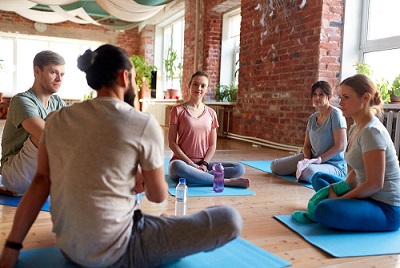Yoga and How it Can Help You Maintain Good Health Naturally
If you’ve never heard of yoga before, you’re likely to doubt its benefits. After all, can stretching and meditation really do something with your health, when you can do other exercises such as running and working out in the gym? Interestingly, it appears there’s more than meets the eye when it comes to yoga, and this often underappreciated art form is actually making waves all around the world. This is because yoga actually has innate benefits that promote not just physical health, but also mental and spiritual health. In this article, we’ll discuss yoga and how it can help you maintain good health naturally.
Yoga: What Are The Numbers Behind It? 
Before you get to learn about the basics of yoga, it’s important to understand that getting into yoga isn’t just “getting into a fad.” In fact, you’re going to be a part of a huge family – as in America alone, 36-million have already tried yoga at some point in their lives, with 80-million more likely to try the craft on their own in the next year. If you think yoga should be practiced alone, a lot of people might disprove you either, as 75-percent of yoga practitioners do workouts aside from yoga. Regardless, a lot of people seem to already notice the benefits of the craft, as 80-percent of practitioners do believe they developed good balance thanks to yoga. In terms of mental health, 86-percent of people who continuously practice yoga do say they have better sense of mental clarity as well. If you’re looking to tra, perhaps services such as Blooming Lotus Yoga may be for you.
Maintaining Health: Does Yoga Help?
Given the above numbers, it appears a lot of people find reason to go to yoga as a means to not just meditate and relax, but to be a consistent means of maintaining their health. However, does yoga really work to be your go-to option for wellness? How does yoga work when it comes to making sure your body and mind are in such a balanced state, that you’re nothing but healthy?
Improve your overall physical strength, flexibility:
When people talk or think about yoga, it’s very likely that they’ll see people on mats doing odd stretches, poses, and meditation stances. However, these aren’t just for show – continuous and rigorous practice and meditation not only affords opportunities for relaxation, but also to improve various aspects of one’s physical health, such as strength and flexibility.
- First-time yogi may not even be able to do backbends or touch their toes during their first few sessions, but they may eventually experience “loosening” in their body that even some “complex” poses are possible. This is because yoga actually gets to improve flexibility over time.
- In fact, overall body strength and flexibility improves because yoga starts to properly align bone placements to the point where hips are loosened that lessen knee joint strain, hamstrings are loosened to avoid flattening the lumbar spine, and eventually help make a lot of back pain and hip pain slowly diminish.
- Strong muscles are attractive because they’re not only there to help you look good, but they’re helpful in terms of avoiding back pain and arthritis. If you want to look good and feel good as you grow older, yoga can definitely help build strength over time.
Strengthen your bones and posture:
Continuous and consistent exposure to various poses and stances through yoga not only improves flexibility and strength in general, but improvements also seep into your bones. Yoga is a good option for those with bone and joint problems because yoga trains the body – especially the bones – to adjust to proper posture in a way that doesn’t strain the body.
- Doing a lot of things everyday – regardless if it’s tasks for work, work for school, or chores at home – these can cause you fatigue. And doing them with the wrong posture can cause more pain and even cause joint, muscle, neck, and back problems that may hit you hard once you grow older. Doing yoga can at least help give you a better way of “reminding” your body to maintain good posture in order to avoid these conflicts moving forward.
- When you do yoga, you make sure your body experiences a full range of motion, which means joints and bones get exposed to a lot of angles that may cause a bit of “pain” at the beginning, but can be a form of relaxation when you get used to it. This “soaking” and “squeezing” of cartilages can help prevent degenerative arthritis, and paying attention to all your body’s parts can help them stay active.
- Yoga can help promote your overall bone health, thanks to meditative stances and poses you continuously do. Twists, forward bends, and backbends can greatly help stabilize your spine, and upward-facing and downward-facing dog (among others) can greatly help improve arm strength.
Amp up your immunity, blood rate:
 One of the more interesting benefits of yoga to practitioners is its ability to increase blood flow across your body, as yoga stances are designed to achieve mind-body balance. In fact, part of what makes yoga a popular relaxation method is precisely on how these stances motivate blood flow. Popular benefits of such improvements include better heart rate and immunity.
One of the more interesting benefits of yoga to practitioners is its ability to increase blood flow across your body, as yoga stances are designed to achieve mind-body balance. In fact, part of what makes yoga a popular relaxation method is precisely on how these stances motivate blood flow. Popular benefits of such improvements include better heart rate and immunity.
- When you do relaxation exercises in yoga, be it through stretching or breathing, these actually help your circulation. Breathing exercises make sure you get more oxygen in cells, and your various poses will make sure blood gets to flow in various parts of the body. This means areas with normally thin blood get revitalized with fresh and healthy blood that can get the body going.
- When blood gets circulated in your body properly, you increase the drainage of a lymph. Lymphs are rich with immune cells, and doing various poses makes sure they get around the body. This, in turn, helps you dispose of toxins in your body, destroy carcinogens, and fight various forms of infection.
- Yoga can also help make sure your risk of depression and heart attack are lowered by making sure your heart rate and cardiovascular health are increased and amped up to manageable levels. This is helpful for those with high blood pressure, as while yoga does help pump blood to your system, it also helps make sure those with high blood pressure have their blood levels regulated instead.
Manage your hormones for stability:
Hormones are known to be chemicals the body releases in order to regulate various aspects of our nervous system, especially our emotions. This is why people have increased adrenaline when stressed, increased cortisol when sad, and increased dopamine when happy. Yoga helps manage these hormones in order to not just affect our emotions, but stabilize other bodily functions as well.
- When the body does something, it releases hormones in order to regulate certain bodily functions. In the case of yoga, it lowers cortisol levels, which normally go up because of stress. Yoga, thanks to its varied techniques in causing relaxation, lowers cortisol which in turn helps increase immunity to diseases.
- Meanwhile, yoga also makes sure certain hormones such as cortisol are regulated so their benefits can still be enjoyed – such as instances where high cortisol levels can improve long-term memory, but not too much that it causes permanent damage to the brain.
- Likewise, the meditative and relaxing benefits of yoga also helps improve symptoms of depression and increase serotonin, which not only improves immunity, but also helps lighten the mood of practitioners.
Help find your center and focus:
One of the popular sayings during yoga sessions is to “find your center” and focus on it as you relax and meditate. This isn’t just a statement for the sake of the “yoga fad,” as meditating and focusing on yoga poses does help relax the body and improve your focus. The benefits of yoga towards mental, emotional, and spiritual health can’t be underestimated, as these benefits remain to be some of the most attractive qualities of the practice.
- Yoga actually benefits those who want to have healthier lifestyles because activities associated with the practice help make sure calories are burned through continuous movement.
- Likewise, the spiritual and emotional aspect of doing yoga may encourage practitioners to reflect upon and address various life concerns and woes without pressuring themselves too much.
- Yoga makes sure its practitioners are trained into slowly finding their focus in order to tackle problems more efficiently, allowing them to have a better sense of clarity and be able to reflect on various life concerns more efficiently and effectively.
The Takeaway: Yoga, And Uniting Mind, Body, And Spirit
If there’s anything the above could share it’s that health doesn’t always need to mean “physical” health. Yoga is built on the foundation of uniting the mind, body, and spirit – and this is done through a series of careful posing, breathing, and meditation, upon others. If you’re looking for a stress-free way to get fit and at the same time relax, yoga can definitely be the kind of fitness and meditative activity you’re looking for. In today’s day and age where there’s a need to adjust to a fast-paced environment, be it in work or school or at home, yoga is a good way to unwind, relax, and ground yourself amid all the pressure.
David Patel
David Patel is an avid yoga practitioner and fitness enthusiast which, combined with his passion for writing, allowed him to write his own unique take on the health and medical niche. As a contributor for sites such as Blooming Lotus Yoga, David ensures his readers get a healthy dose of informative, entertaining, and enjoyable writing whenever he posts his pieces. Aside from yoga, David also loves cooking during his free time.

Pingback: 15 Tips to Manage Mood Swings Naturally
Pingback: 6 Simple & Easy Ways to Help Cure Your Depression ASAP
Pingback: Discover the Richness of Online Yoga with Glo
Pingback: 5 Simple Ways to Include Yoga in Your Daily Routine
Pingback: Healthy Habits for a Sober Lifestyle
Pingback: 6 Amazing Outdoor Activities Improve Your Health
Pingback: Seven Reasons Why You Are Bloating